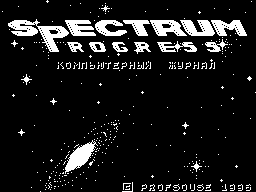|
Spectrum Progress #01
30 сентября 1996 |
|
Notes programmer - univkrsalnaya library for working with graphics from Vyacheslav Mednonogova - Graphic Library v1.1

Graphic Library v1.1
(C), Vyacheslav Mednonogov, 1991.1992.
(C) a description - Vyacheslav Mednonogov, 1996.
The growing popularity has led to the ZX Spectrum
the fact that many of those who see this
computer only as a toy, now be happy to learn it as a powerful
tool programming. And if a year or two ago it
could only go about BASIC, but now interest
causes the assembler. It is not too complicated language
However, for some, especially novice programmers obstacle is
the output of graphics developed in their system and application
programs.
To help them, I offer my graphics
library, which became the core of the game "Tankodrom. She
also came into play and "Pinocchio." With some modifications,
this library is included, as auxiliary, a game of "UFO. The
enemy is unknown."
Hallmarks Graphic Library
(GrLib1.1) are small size (880 bytes)
versatility, ability to work with all the usual procedures and
shadow screens, sprites and output attributes in all possible
ways overlay, building points and segments. In addition, it
included the procedure of integer multiplication and division.
Another important advantage is
that all procedures (except GETSIM and GETSCR) work properly
with any input parameters, so even if you make a mistake in
setting the coordinates of points, lines, sprites, or the size
of primitives, through my fault your program does not fly
(although in that case, if properly used the setup screen
SELSCR).
The disadvantages is that, as
and any universal and compact Library
She has speed, insufficient for writing serious dynamic games
(like "ELITE" or "UFO"). Yet her performance menie more than
enough to repeat most of currently existing games.
So, what is included in GrLib1.1:
a) The mathematical sub-library:
MULB2 HL * E-> DE Multiplication
MULB L * E-> DE Flag C-overflow
MUL HL * DE-> DE
DIVB E/L-> E Division
DIVB2 DE/L-> E D-residue.
Overflow
or division by zero
E-> D; 255 -> E
b) Vector Graphics:
LINE - the line between (X1 = E; Y1 = D) and (X2 = L; Y2 = H)
PLOT - output point (X = E; Y = D)
c) Printing of characters:
PRINT - output drains of characters:
A - number of
D - initial coordinate along the vertical
whether (in the familiarity).
E - Horizontal
HL-address of the beginning of the text
BC-address table used by Sim
oxen.
SIMBOL - print a single character multiple times
A - number of repetitions
L - character code
BC and DE - in PRINT
STRLEN - string length to find a separator
0 or 13
HL - beginning of line
Output:
A - number of characters per line
Example: LD HL, TEXT
PUSH HL
CALL STRLEN
POP HL
LD BC, # 3C00; character set in ROM
LD DE, # 0502
CALL PRINT
RET
TEXT DEFM "Hello, World"
DEFB 0
d) Work with sprites:
for the following listed procedures
H - Y coordinate
L - X coordinate
B - width of familiarity
C - height of familiarity
DE - address of the image in memory
- Output sprites XY
PUTSPR in pixels in the familiarity
PUTSCR in pixels, in pixels
PUTSIM in familiarity, in pixels
- Filling in the window of bytes from the register A
SIMBAR X and Y coordinates of familiarity
- Save the image in the sprite memory
DE - buffer address to save the sprite
GETSIM X and Y coordinates of familiarity
- Display the attributes of the sprite on the screen
PUTATR (parameters as in PUTSIM)
- Set recording attributes of the sprite in the buffer address
Register DE
GETATR (parameters as in GETSIM)
- Fill out the window attributes of one color from
register A
ATRBAR (parameters as in SIMBAR)
e) Establish a way to overlay primitives
Call:
LD A, <mode>
CALL CHNGRG
where <modename> has the following mnemonics:
* NOP_ - Up
OR_ - sanctioned by PRINCIPLE OR
XOR_ - on PRINCIPLE "XOR"
* AND_ - on PRINCIPLE AND
* INV_ - inversion
* - Only for PRINT, PUTSIM, PUTSPR
- Select the screen (SELSCR)
In all their games, I rarely form IMAGE
reflection on the main screen: first, I build
it in the "shadow" screen, then quickly
forwards it to the core.
Shadow screen - any region in the parameter
myati length 6 KB (6,912 bytes).
GrLib imposes restrictions, according to
which the address of the beginning of the "shadow" screen
must be a multiple of # 0800 (2048).
Selecting the screen is carried out as follows:
LD A,
CALL SELSCR
To display a normal screen, use:
LD A, # 40
CALL SELSCR
If you do not call SELSCR, by default, all
procedure output in the main
screen.
If you do not call CHNGRG, the default mode OR_.
The remaining procedures are complementary.
GrLib 1.1 in games "Tankodrom and
"Pinocchio" (in "Pinocchio" - after decompression
address 64640). You are able to see how
they are used in these games with a debugger, or the shadow of
the monitor.
Over three years of operation, I found only
two facts:
MULB, MULB2, MUL - not always correctly
expose the carry flag, so if you want to build on their basis
multiplication 04.08 byte numbers, they should be changed.
PUTATR, GETATR - work only with the attributes of the main
screen. Before the advent of games on the 128K it does not
matter much. As workshop on programming you can try yourself to
remove this shortcoming.
Compile and run GrDemo and you get some idea of GrLib 1.1.
All the best, success in the writing game
Dear Colleagues,
From the Editor SP:
The annex to the magazine you will find the graphics library
and demonstration program. We remind you of the need to
initialize Applications for free access to the files.
Other articles:
Similar articles:
В этот день... 30 December